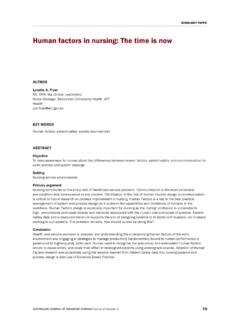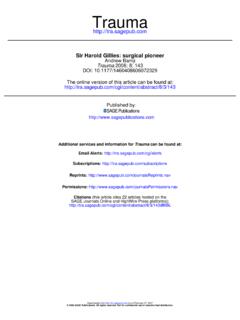Transcription of FUTURE SCHOOL - Aalto
1 Publications in Architecture 2009/100. FUTURE SCHOOL . - Designing With Children Author Sini Meskanen Editor Helena Ter v inen Arkkitehtuurin julkaisuja - Publications in Architecture 2009/100. Teknillinen Korkeakoulu Arkkitehtuurin laitos PL 1300. 02015 TKK. Copyright 2009 author &. photographers ISBN 978-951-22-9836-5 (paper). ISBN 978-951-22-9837-2 (network). ISSN 1797-352X (paper). ISSN 1797-8351 (network). Layout & Cover Sini Meskanen Painotalo Casper Oy Espoo Publications in Architecture 2009/100. FUTURE SCHOOL . - Designing With Children Author Sini Meskanen Editor Helena Ter v inen FUTURE SCHOOL . - Designing With Children Table of Contents Part 1 - Typologies for the and Roof Gardens 36.
2 FUTURE SCHOOL - Introduction 2. Workshop 9 - SCHOOL FUTURE SCHOOL Appearance, Form and Layout 42. Workshops - Curriculum 4. The Themes Arise 52. Workshop 1 - From Own Experiences to Inspiring Space 6 Part 2 - Typologies for the FUTURE SCHOOL 54. Workshop 2 - Own Space and Learning Space 10 1st Typology - Piazza 56. Workshop 3 - Learning Space 2nd Typology - Roof Garden 60. Groups and Clusters 14. 3rd Typology - Stoa 64. Workshop 4 - Common Spaces in FUTURE SCHOOL 18 4th Typology - Series of Atriums 68. Workshop 5 - Meeting Places in 5th Typology - Heart, Bridge and FUTURE SCHOOL 22 Clusters 72. Workshop 6 - Specialized Spaces Conclusions 76.
3 In FUTURE SCHOOL 26. How to Use Typologies as Workshop 7 - Clusters and Methodologies 78. Patterns 30. References Workshop 8 - Outdoor Spaces Literature and Photographs 80. 1. Part 1. Typologies for the FUTURE SCHOOL Introduction 2 Kaapelitehdas - Cable Factory Our research questions are pointing on two directions: In what ways can the collabora- Collaborative planning and design tive planning and design process with chil- constructing children s epistemic dren act as a tool for active citizenship and agency cultural learning? In what ways does children's environmental local knowledge enrich urban planning? It is most important, even crucial, for people's Several sub-studies have been carried out well-being to deal with the decisions concern- with pupils to produce data of their environ- ing their own environment.
4 The group which ment by different methods and this paper is is usually forgotten even in the most collab- aiming to describe one of them. In the sub- oratively arranged urban planning and design study at Arkki ( SCHOOL of Architecture for processes are the children. Children and Youth), several planning and design workshops were organized for chil- The research project called InnoArch, Places dren to examine their visions for a better fu- and Spaces for Learning, belongs to a trans- ture SCHOOL . disciplinary InnoSchool consortium aiming to develop a set of research-based good prac- Students in two age groups (7-11 and 12- tices, processes, models and designs for the 18) were producing ideas of their own in FUTURE SCHOOL Concept.
5 Scale models, texts and drawings for the SCHOOL building and the environment. The InnoArch focuses the research at two main workshops were documented in photographs goals: first to deepen the understanding of and videotapes. The main idea of the work- the interrelationship between a spatial expe- shops has been to ask: What would children rience and meaningful learning process; and do, if they had a chance to design a SCHOOL then to develop a collaborative, inquiry based building? planning and design process for the FUTURE SCHOOL . The research project has several sub- In this book we are describing the study studies which are dealing at different physi- made at Arkki SCHOOL and the typologies of cal and virtual levels: building design and the FUTURE SCHOOL which Sini Meskanen dis- architecture, neighborhood design and global covered in this research and presented in her networking.
6 Master s thesis in Architecture Spring 2008. at the Department of Architecture, Helsinki The pedagogical idea based on inquiry-based University of Technology. learning encourages to strengthen children's (pupils) epistemic agency in the local com- munity and to empower them to be active stakeholders in it. We invited pupils to take part in the planning and design process by developing methods to find out what kinds of places and spaces attract them and why. 3. FUTURE SCHOOL Workshops &. Curriculum Workshop Date Topic 1. Workshop & From Own Experiences to Inspiring Space 2. Workshop & Own Space and Learning Space 3. Workshop & Learning Space Groups and Clusters 4.
7 Workshop & Common Spaces in FUTURE SCHOOL 5. Workshop & Meeting Places in FUTURE SCHOOL 6. Workshop & Specialized Spaces in FUTURE SCHOOL 7. Workshop & Clusters & Patterns 8. Workshop & Outdoor Spaces and Roof Gardens 9. Workshop & SCHOOL Appearance; Layout, Plan, Ground Plan 9. Workshop Perspectives, Scale Models Final seminar Discussion and analysis of the results. Photos. 4. FUTURE SCHOOL workshops were held in the Then it was considered whether SCHOOL build- fall 2007 at Arkki ( SCHOOL of Architecture for ings should evolve too, and if so, how and Children) in Kaapelitehdas, Helsinki. Two what should change. The day's theme was groups of 12 students each were assembled discussed and the students presented ques- once a week for the entire fall semester, tions and comments.
8 Some questions were totalling 21 gatherings. The students were chosen to support the design work: What aged between 9 and 18, but the other les- kind of spaces are intriguing, interesting and son series was also participated by a young- promote learning? What colours, shapes, er, 7-9-year old children's group. materials and atmospheres are interesting and promote the learning experience? In the curriculum of FUTURE SCHOOL -work- Students worked independently with the de- shops the SCHOOL and its surroundings were sign tasks given. They drew layouts, projec- divided into nine different themes. The re- tions, perspective images and sections ac- search was taken further towards SCHOOL of cording to their own interests and purposes.
9 The FUTURE through analysing the students' The students also wrote notes on their ideas schools of today. The analysis started from and observations on spaces and their us- smaller, more private spaces gradually de- age. The older students produced sketches veloping towards larger spatial groups and in each workshop, varying their own themes;. spaces. According to the principles of inquiry- whereas the younger students seemed to based learning, the students built their un- prefer scale models as their means of self derstanding on what they had learned from expression. previous stages by gradually moving towards larger spatial entities.
10 Fall semester ended As the workshop went on, the students dis- with a seminar in which the teacher Sini Mes- cussed their work with each other and with kanen, student of architecture, and research- the teacher. In the end of a workshop each er Helena Ter v inen, (Tech), Architect, student presented his work to the teacher also the advisor of thesis, discussed and ana- and other students as the researcher video- lysed the plans and the work done with the taped the discussion. During the interview students and their parents. the students had a chance to develop their epistemic agency and by words increase oth- Sini Meskanen, at the time a student of ar- ers' knowledge about their designs.








